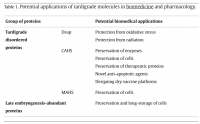
Lovely tiny virtually indestructible beast, Sir Tardigrade.
A study just broke out of Tokyo that says some eyebrow-raising things about water bears and their DNA. First among the revelations is the finding that water bears might not be all that much not-tardigrade at all. Remember that story about the tardigrade genome being about 17% foreign DNA? The Tokyo University team suspected that might have been because of contamination. So, for their own experiments, they took some extra precautions when getting ready to make their little vials of extract of tardigrade. And by precautions, I mean dosing the water bears with antibiotics and soaking them in bleach. It’s like how a surgeon scrubs before surgery; any microbe that can hang on through that chemical and physical onslaught probably belongs there, so it’s easier to mind their potential for contamination because we know to look for it.
The particular kind of water bear the researchers chose to work with is also germane. The prior art used a relatively squishy species of freshwaterbear (is that a word? It’s a word now) called Hypsibius dujardini, whereas the Tokyo study decided to use the hardier Ramazzottius varieornatusprecisely because it’s so tough to kill, and they wanted to find out why.
When the results of the sequencing came back, the Tokyo researchers found that the tardigrade genome was composed of more like 1.2% foreign DNA, which is a far cry from a sixth of the thing’s genes coming from lateral gene transfer. In their paper, they politely refer to the previous, possibly adulterated results as a “draft genome.”
What they did find in the cleaner, less fragmented genome was a series of proteins, which protect the water bears’ DNA from damage. Some manage the organism’s response to oxidative stress or dehydration. They have four copies of a gene coding for proteins good at repairing DNA double-strand breaks, like those resulting from physical damage, such as decompression, dehydration, or freezing. And there’s one notable protein that’s specific to water bears, capable of repairing DNA damage from high doses of radiation.
The Tokyo University researchers were even able to watch the protein go about its work by tagging parts of the tardigrade genome with green fluorescent protein (GFP) and then watching as the protein migrated through cells in culture. The damage-suppressing protein, Dsup, is closely associated with nuclear DNA; the scientists found it in the chromatin fragment of their cream-of-tardigrade soup. Chromatin is sort of like the options page of the DNA molecule, in that it determines which parts of the DNA molecule are transcribed.

This is where it gets a little weird.
When the team treated human cells in culture with extract of tardigrade, the GFP-tagged proteins stuck to human DNA just like they stick to tardigrade DNA, and cheerfully started doing what they do best: tamping down oxidative stress. When X-rays hit human cells, they do two kinds of damage. X-rays can cause direct DNA strand breaks, which are mostly single-strand. When they strike water molecules, they can also excite them into producing reactive oxygen species, which also cause single-strand breaks. High enough doses of X-rays can cause double-strand breaks. The damage-suppressing protein Dsup went immediately to work on the culture of human cells, suppressing or repairing single-strand and double-strand breaks by about 40%.
Clearly this means we can consume water bears to gain their powers. The study authors remark that the gene portfolio of the tardigrade represents “a treasury of genes” to improve or augment stress tolerance in other cells. Plug-and-play genetics, anyone?
Also: in the course of researching this story, I discovered that in 2008 there was an ESA-sponsored tardigrade science project called TARDIS: TARDigrades In Space. The ESA also did an experiment where they stuck Martian rocks into the heatshield of a spacecraft and found out that re-entry ablated away the top two-thirds of the dolomite, implying that nothing shallower than an inch deep in the rock could possibly survive the trip. Obviously this doesn’t make hard conclusions about the idea of panspermia, but it does require us to examine our assumptions about how life on our planet might have begun.
















































